Push notifications are clickable pop-up messages displayed on device screens, chiefly desktops and smartphones. The technology originally served for sending non-advertising notifications. Apple was the first who implemented push technology for its devices in 2009. The company created Apple Push Notification service (APNs) that enabled iOS developers to send notifications to apps installed on Apple devices.
Today push notifications are well-known as advertising technology that is supported by Android, giants Google and Microsoft. Push notification ads also can be viewed almost on most browsers and delivered on any smart devices that are connected to the Internet, for example, tablets and consoles. Although push ads appear anywhere, they are voluntary. The point is, that users should subscribe to notifications before they start receiving push ads.

Looking at the examples of notifications above, we’ll describe their elements.
What is push ads according to its elements:
All elements are clickable since a push ad contains a URL that allows users to land on the offer page or pre-landing containing a link to the landing page. The pre-landing page serves as part of the sales funnel which is an important stage of the user’s journey and a sort of filter for uninterested ad recipients.
Push ads are based on the subscription model. It works in the following way: a user visits the website and click the subscribe button to start getting push notifications. At the same time, they are eligible to close the window. Users who choose the first option become push ad recipients soon. Over time, subscribers receive various notifications that can include offers, updates, news, or other relevant content, depending on the website’s focus and the user’s interests.
Push ads are a popular format among marketers due to their profitability. Here’s a concise overview of their benefits and downsides:
At present, there are many types of push notifications available for advertising purposes. The most popular formats are the following:
This technology implies sending out classic push notifications through desktop or mobile browsers. Usually, push ads pop up at the right-hand side or top of the screen, depending on the operating system being used by a subscriber.

Unlike classic push notifications, in-page push ads are sort of popunders, stylized as push notifications. Notably, this ad type was invented to engage iOS users that hadn’t seen notifications from websites before.

These ads are displayed on iOS devices via the сalendar application, imitating a scheduled event. Similar to push ads, users receive calendar notifications right on their devices regardless of whether they are online or not.

Push advertising is useful as a way to cover a wide variety of verticals. The following verticals tend to have higher click-through and conversion rates than the other ones, which makes them more profitable for marketers.
The list of best verticals for push notifications:
Most of the used cost models in push advertising are CPC and CPM.
Let’s take a closer look at them:
| CPC | CPM |
|---|---|
| Stands for: Cost Per Click | Stand for: Cost Per Mille (1K impressions) |
| Context: Advertisers pay for only user’s clicks | Context: Advertisers pay for every 1K impressions |
| Best for: Generation of conversion-centered campaigns | Best for: Broad audience marketing, in particularly increasing brand awareness |
Advertisers often choose the CPC cost model because of knowing how many clicks they can get according to their campaign budget. And on this basis, the CPC model seems to be more simple and less risky, unlike CPM.
Dating:
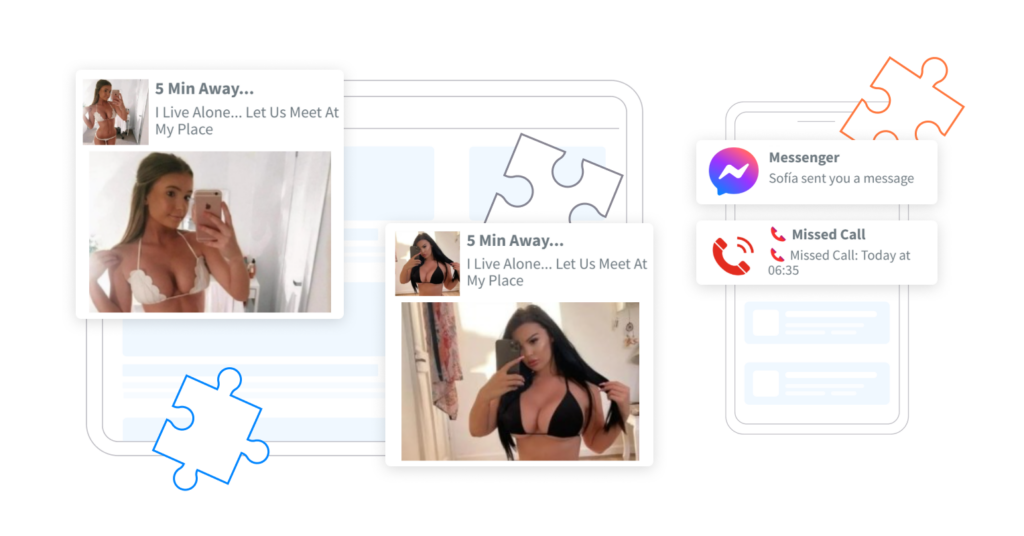
Gambling:

Antivirus:
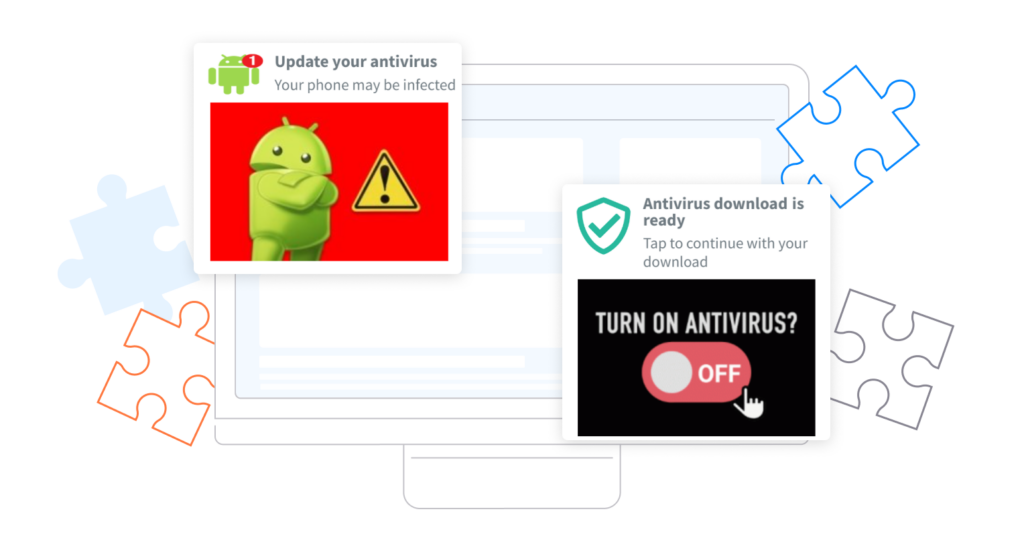
Sweepstakes:
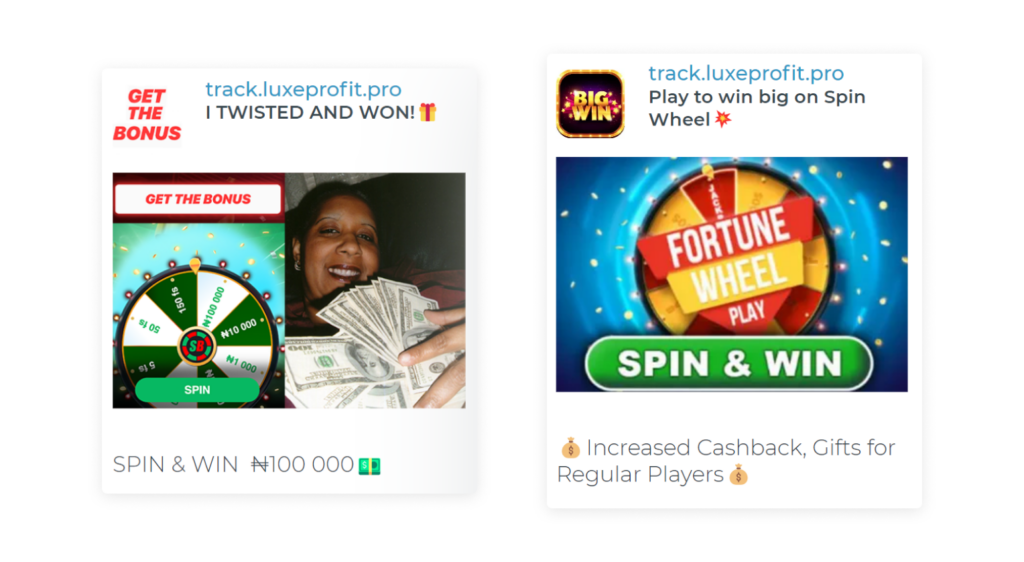
Nutra:

To promote their offers, advertisers need publishers who have their own websites. Publishers or site owners, in turn, are interested in collaboration with advertisers because their purpose is to monetize existing traffic. Obviously, publishers can create an opt-in form for collecting subscriptions through a special plugin, but this way takes much time and reach only website visitors.
The most effective way to monetize or buy traffic is cooperation with push ad agencies that meet the needs of both sides:
Push ads networks aggregate many site owners in one place, giving access to a great amount of traffic for advertisers.
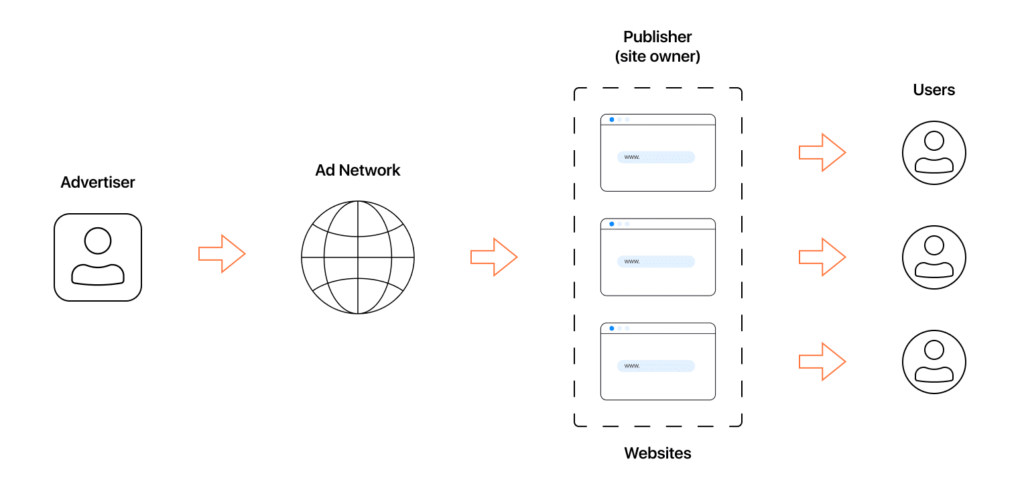
Subscribers lists are the largest traffic source in any ad platform. Each list can include several publishers. And accordingly, each publisher can have either one site or multiple ones.
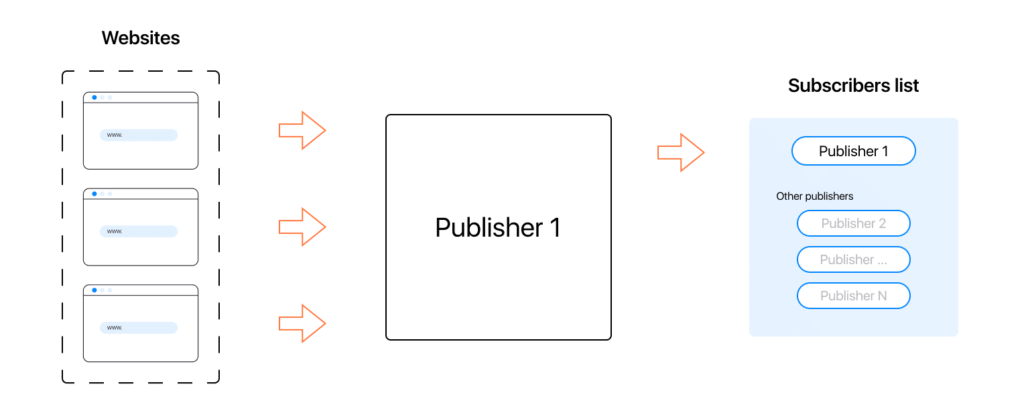
Networks offer full service for creating campaigns, not limited to only the collection of subscriber databases. These are multiple targeting options, subscribers lists prepared for particular verticals, optimization tools and other perks.
From crafting creative assets to assessing performance, consider these best practices.
Creating personalized, compelling push notifications is key to capturing user attention. Tailor messages to align with their interests, requirements, or past interactions. Also, contemplate notification frequency and timing to avoid overwhelming users and maintaining their subscriptions. Balancing informativeness and non-intrusiveness is crucial.
Segmentation plays a crucial role in delivering personalized and relevant push ads to your subscribers. Categorize your audience based on traffic quality (premium/medium/low) and user freshness after you conduct the first tests to refine future ad campaigns. This allows you to target specific segments with tailored ads, increasing the chances of conversion.
Finding the right balance in frequency and timing of push notifications is paramount for user engagement and retention. Bombarding users with excessive notifications can lead to opt-outs, while infrequent notifications may result in lower revenue potential. Monitor analytics to optimize the frequency of your push ads to align with users’ preferences. In general, one click per user per day is recommended.
As for timing, some conventional behavior patterns help set up a well-performed schedule at the onset. For example, when it comes to launching gambling offers, it is often recommended to focus in the evening hours, typically from 7 pm to 11 pm, as this is when many people have finished their duties and are more likely to engage in online gambling.
Continuous testing and optimization are key to improving your push ad monetization efforts. Analyze the performance metrics such as click-through rates, conversion rates, and revenue generated to identify the most effective variations. Exclude non-performing sources and add conversion-driven ones in whitelists. Make use of such features as Automauted rules and Microbidding to maximize monetization potential.
Create several variations of creatives and keep track of performance on each of them. For a while, you will catch up good targeting presets for your push campaigns.
In nutshell, never stop working on your campaign. Analyze, test, and fine-tune its settings.
Monitoring crucial metrics such as click-through rates, clicks, and conversion rates is essential to evaluate the success of push ad campaigns. Ad platforms offer extensive tracking and analysis capabilities to effectively measure the performance of push traffic campaigns.
Push notifications are clickable pop-up messages displayed on device screens, chiefly desktops and smartphones. The technology originally served for sending non-advertising notifications. Apple was the first who implemented push technology for its devices in 2009. The company created Apple Push Notification service (APNs) that enabled iOS developers to send notifications to apps installed on Apple devices.
Today push notifications are well-known as advertising technology that is supported by Android, giants Google and Microsoft. Push notification ads also can be viewed almost on most browsers and delivered on any smart devices that are connected to the Internet, for example, tablets and consoles. Although push ads appear anywhere, they are voluntary. The point is, that users should subscribe to notifications before they start receiving push ads.

Looking at the examples of notifications above, we’ll describe their elements.
What is push ads according to its elements:
All elements are clickable since a push ad contains a URL that allows users to land on the offer page or pre-landing containing a link to the landing page. The pre-landing page serves as part of the sales funnel which is an important stage of the user’s journey and a sort of filter for uninterested ad recipients.
Push ads are based on the subscription model. It works in the following way: a user visits the website and click the subscribe button to start getting push notifications. At the same time, they are eligible to close the window. Users who choose the first option become push ad recipients soon. Over time, subscribers receive various notifications that can include offers, updates, news, or other relevant content, depending on the website’s focus and the user’s interests.
Push ads are a popular format among marketers due to their profitability. Here’s a concise overview of their benefits and downsides:
At present, there are many types of push notifications available for advertising purposes. The most popular formats are the following:
This technology implies sending out classic push notifications through desktop or mobile browsers. Usually, push ads pop up at the right-hand side or top of the screen, depending on the operating system being used by a subscriber.

Unlike classic push notifications, in-page push ads are sort of popunders, stylized as push notifications. Notably, this ad type was invented to engage iOS users that hadn’t seen notifications from websites before.

These ads are displayed on iOS devices via the сalendar application, imitating a scheduled event. Similar to push ads, users receive calendar notifications right on their devices regardless of whether they are online or not.

Push advertising is useful as a way to cover a wide variety of verticals. The following verticals tend to have higher click-through and conversion rates than the other ones, which makes them more profitable for marketers.
The list of best verticals for push notifications:
Most of the used cost models in push advertising are CPC and CPM.
Let’s take a closer look at them:
| CPC | CPM |
|---|---|
| Stands for: Cost Per Click | Stand for: Cost Per Mille (1K impressions) |
| Context: Advertisers pay for only user’s clicks | Context: Advertisers pay for every 1K impressions |
| Best for: Generation of conversion-centered campaigns | Best for: Broad audience marketing, in particularly increasing brand awareness |
Advertisers often choose the CPC cost model because of knowing how many clicks they can get according to their campaign budget. And on this basis, the CPC model seems to be more simple and less risky, unlike CPM.
Dating:

Gambling:

Antivirus:

Sweepstakes:

Nutra:

To promote their offers, advertisers need publishers who have their own websites. Publishers or site owners, in turn, are interested in collaboration with advertisers because their purpose is to monetize existing traffic. Obviously, publishers can create an opt-in form for collecting subscriptions through a special plugin, but this way takes much time and reach only website visitors.
The most effective way to monetize or buy traffic is cooperation with push ad agencies that meet the needs of both sides:
Push ads networks aggregate many site owners in one place, giving access to a great amount of traffic for advertisers.

Subscribers lists are the largest traffic source in any ad platform. Each list can include several publishers. And accordingly, each publisher can have either one site or multiple ones.

Networks offer full service for creating campaigns, not limited to only the collection of subscriber databases. These are multiple targeting options, subscribers lists prepared for particular verticals, optimization tools and other perks.
From crafting creative assets to assessing performance, consider these best practices.
Creating personalized, compelling push notifications is key to capturing user attention. Tailor messages to align with their interests, requirements, or past interactions. Also, contemplate notification frequency and timing to avoid overwhelming users and maintaining their subscriptions. Balancing informativeness and non-intrusiveness is crucial.
Segmentation plays a crucial role in delivering personalized and relevant push ads to your subscribers. Categorize your audience based on traffic quality (premium/medium/low) and user freshness after you conduct the first tests to refine future ad campaigns. This allows you to target specific segments with tailored ads, increasing the chances of conversion.
Finding the right balance in frequency and timing of push notifications is paramount for user engagement and retention. Bombarding users with excessive notifications can lead to opt-outs, while infrequent notifications may result in lower revenue potential. Monitor analytics to optimize the frequency of your push ads to align with users’ preferences. In general, one click per user per day is recommended.
As for timing, some conventional behavior patterns help set up a well-performed schedule at the onset. For example, when it comes to launching gambling offers, it is often recommended to focus in the evening hours, typically from 7 pm to 11 pm, as this is when many people have finished their duties and are more likely to engage in online gambling.
Continuous testing and optimization are key to improving your push ad monetization efforts. Analyze the performance metrics such as click-through rates, conversion rates, and revenue generated to identify the most effective variations. Exclude non-performing sources and add conversion-driven ones in whitelists. Make use of such features as Automauted rules and Microbidding to maximize monetization potential.
Create several variations of creatives and keep track of performance on each of them. For a while, you will catch up good targeting presets for your push campaigns.
In nutshell, never stop working on your campaign. Analyze, test, and fine-tune its settings.
Monitoring crucial metrics such as click-through rates, clicks, and conversion rates is essential to evaluate the success of push ad campaigns. Ad platforms offer extensive tracking and analysis capabilities to effectively measure the performance of push traffic campaigns.